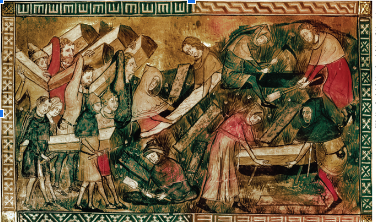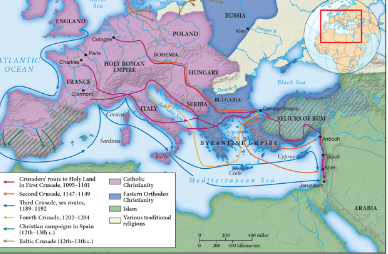UNIT 2: Section by section--google responses
5.0(3)
5.0(3)
Card Sorting
1/27
Earn XP
Description and Tags
Study Analytics
Name | Mastery | Learn | Test | Matching | Spaced | Call with Kai |
|---|
No study sessions yet.
28 Terms
1
New cards
What was the economic and cultural impact of the Silk Road trading network?
Religion and ideas spread along the Silk Road just as fluidly as goods. Towns along the route grew into multicultural cities. The exchange of information gave rise to new technologies and innovations that would change the world
2
New cards
What lay behind the emergence of Silk Road commerce, and what kept it going for so many centuries?
The Silk Road was a vast trade network connecting Eurasia and North Africa via land and sea routes. The Silk Road earned its name from Chinese silk, a highly valued commodity that merchants transported along these trade networks. Advances in technology and increased political stability caused an increase in trade.
3
New cards
What facilitated the spread of Buddhism along the Silk Roads?
The development of trade amongst merchants of the region along the Silk Roads resulted in a further expansion of Buddhism towards eastern Asian lands, especially in Thailand and Indonesia regions
4
New cards
How did Buddhism change as it spread beyond its place off origin?
As it spread, new versions emerged to meet the different needs of converts. For example, Mahayana Buddhism, which means "the great vehicle," allowed people to strive toward enlightenment even if they couldn't become monks.
5
New cards
What facilitated the initial acceptance and spread of Buddhism in China?
The Silk Road is what originally encouraged the spread of Mahayana Buddhism into China. Its emphasis on pure land faith and salvation made it immensely more popular than studying or immense meditation.
6
New cards
What cultural changes occurred in Korea and Japan in response to Chinese influence?
The Chinese influence in Korea ruined the role of women in Korean culture. Women who were once allowed to raise her children in her parents' home were frowned upon because due to the Confucian ideas, women belonged to her husband's family. Women could no longer inherit property or remarry. Confucianism changed the Korean view on women.
\
\
* Japanese elite, then broader Japanese society, borrowed heavily from Chinese culture
* Elite class studied Neo-Confucianism teachings, history, calligraphy, and poetry
* Chan Buddhism → Zen Buddhism in Japan (popular among the samurai class)
* Neo-Confucianism adapted as the official ideology by the Japanese Tokugawa regime in the 17th century
\
\
* Japanese elite, then broader Japanese society, borrowed heavily from Chinese culture
* Elite class studied Neo-Confucianism teachings, history, calligraphy, and poetry
* Chan Buddhism → Zen Buddhism in Japan (popular among the samurai class)
* Neo-Confucianism adapted as the official ideology by the Japanese Tokugawa regime in the 17th century
7
New cards
What was the significance of the Mongol Empire in world history?
the Mongol empire inextricably linked Europe and Asia and ushered in an era of frequent and extended contacts between East and West.
8
New cards
What were the primary influences on the process of Mongol state building?
the value of which they followed: "Merit is more than worth." Like Confucian societies which allowed people to test into the imperial bureaucracy, the Mongols valued merit.
9
New cards
What accounts for the political and military success of the Mongols?
Strong communication, Trade, fierce organized military, strong trade freedom, taxation, welcomed many religious traditions.
10
New cards
How did Russians experience Mongol rule?
, much of the material culture of the Rus was destroyed. Cities were burned to the ground, civilians were sold into slavery or murdered, and no doubt was left that the land now belonged to the Mongols
11
New cards
How did Mongol rule change China?
The Mongol conquest of the Song empire had, for the first time since the end of the Tang, reunified all of China.
12
New cards
How was Mongol rule in Persia different from that in China? How was it similar?
The Mongol rulers in Persia were transformed far more than their counterparts in China were, as the Mongols made extensive use of the sophisticated Persian bureaucracy. Unlike what occurred in China, the Mongols who conquered Persia converted in large numbers to the local Muslim faith.
13
New cards
How did Mongol rulers continue using Chinese traditions to govern?
In the early phases of conquest, the Mongols usually attempted to impose the social structure of the steppes upon their new subjects. It was customary for the Mongols to enslave a conquered tribe and to present whole communities to distinguished military leaders as a sort of personal appanage.
14
New cards
How did the Mongol Empire lead to cross-cultural interactions?
By bringing such vast lands under one political rule, the Mongols brought peace to these regions and facilitated travel and trade. Products from Russia and Anatolia made their way to Persia and China which created cultural exchanges.
15
New cards

Based on your knowledge of world history and the evidence in this image, what were the social effects of the plague in Western Europe?
People abandoned their friends and family, fled cities, and shut themselves off from the world. Funeral rites became perfunctory or stopped altogether, and work ceased being done.
16
New cards
In what ways did the Sea Roads network generate political, economic, and cultural changes in the region?
\
* Environmental factors
* Maritime trade could carry bulk goods on ship
* could focus on goods for mass markets
* depended on monsoon winds
* Social influence
* diasporic communities formed to facilitate trade
* led to the diffusion of language & culture
* Goods that drove trade
* Chinese porcelain, Indian cotton & pepper, E. African ivory & gold, Arabian incense
* Environmental factors
* Maritime trade could carry bulk goods on ship
* could focus on goods for mass markets
* depended on monsoon winds
* Social influence
* diasporic communities formed to facilitate trade
* led to the diffusion of language & culture
* Goods that drove trade
* Chinese porcelain, Indian cotton & pepper, E. African ivory & gold, Arabian incense
17
New cards
Wealth from sea roads and commerce helped build large, centralized states/cities even beyond the coastal areas was funded by what?
Great Zimbabwe (1250-1350) was source of gold demanded on the Swahili coast. Labor power constructed huge, thick stone enclosures
18
New cards
To what extent did the Silk Roads and the Sea Roads operate in a similar fashion? How did they differ?
• Commerce was the purpose for creating and maintaining these networks. \n • Spread of ideas and technology along the routes. \n • The commercialization of communities along the routes. \n • The role that powerful states played along the two routes.
19
New cards
How could technological developments, such as the dhow ship, help transform the culture of the Indian Ocean region?
help transform the culture of the Indian Ocean region by connecting areas from across the ocean. This would lead to more travel and trade between these areas and eventually cultural diffusion
20
New cards
What factors would have encouraged Ming expeditions to the port cities on this map?
This would have attracted the Chinese on the Ming expeditions because they were looking for people to bring into the tribute system in China.
21
New cards
What were the major economic, social, and cultural consequences of Silk Road commerce?
1\. peasants stop cultivating crops and moved on producing silk, paper, porcelain, lacquer-ware, or iron tools \n 2. merchants got fortunes from long-distant trad
22
New cards
How did the Sand Roads contribute to the spread of Islam in West Africa?
The routes connected West Africa to the Islamic world, particularly the Middle East, and facilitated the exchange of goods, ideas, and technologies between these regions.
23
New cards
What changes did trans-Saharan trade bring to West Africa?
Trans-Saharan trade caused West Africa to develop civilizations and city-states that had complex systems such as monarchies (politics) and more commerce (economics) as they now had more motives to.
24
New cards
How did the expansion of Islam lead to the spread of learning?
Many Islamic schools were established that educated citizens. People learned Arabic and became more literate.
25
New cards
Explain how this mosque in West Africa is an example of cultural diffusion.
This mosque in West Africa is an example of cultural diffusion because it shows how Islam spread all the way to Africa. The Africans then adopted the religion and constructed a mosque (which is the place of worship for Islam). This displays the diffusion of a Middle Eastern religion into an African civilization
26
New cards

**How might this map be used to support the thesis that the Crusades were about much more than just securing the Christian holy sites in Jerusalem?**
COULD BE WRONG: helped both to militarize the medieval western Church and to sustain criticism of that militarization. I
27
New cards
What was the relationship between long-distance trade networks and the religion of Islam?
any long-distance exchange had to traverse Muslim lands, giving trade a central role in the further propagation of the religion. Muslim merchants carried the message of Islam wherever they traveled.
28
New cards
What were the major political and cultural effects of the Crusades?
While the Crusades ultimately resulted in defeat for Europeans and a Muslim victory, many argue that they successfully extended the reach of Christianity and Western civilization. The Roman Catholic Church experienced an increase in wealth, and the power of the Pope was elevated during the Crusades.